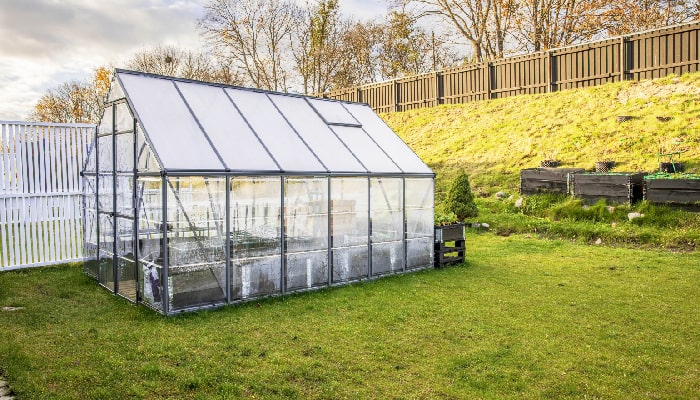Building a greenhouse is a big task. It requires careful consideration of multiple factors to ensure success. Perhaps one of the most important decisions you’ll have to make is the choice of material for the covering. There are several options available when it comes to materials. Yet one of these materials truly sands out: polycarbonate. What is most remarkable about polycarbonate is its durability, light transmission properties, and insulation capabilities. However, what many people want to know when working with this modern material is “how thick should polycarbonate be for a greenhouse to perform the best?” This comprehensive guide will get into this question, hoping to give you the knowledge you need to make the best decision.
Understanding Polycarbonate
Before we get into the details of thickness, it’s important to understand what polycarbonate is and why it’s a popular choice for greenhouses. Polycarbonate is a type of plastic that is incredibly durable and resistant to both high and low temperatures. It’s a thermoplastic, meaning it can be heated and cooled repeatedly without losing its shape or properties. This makes it an ideal material for environments that experience significant temperature fluctuations—think about how a greenhouse could be exposed to cold in the morning and night, but then get very warm from the sunlight at noon!
Polycarbonate is also known for its ability to transmit light. Because light is necessary for plant growth, this is a key feature for building greenhouses. Polycarbonate allows the majority of the sun’s light to pass through while blocking harmful UV rays. Think about how happy your plants or crops will be with all the light they need, but without the risk of damage from overexposure to UV radiation!
Because different greenhouses face different environments and climate conditions depending on their geographic location, one size does not fit all. There need to be different polycarbonate thickness options that can perform well in the different situations. This is why, in every project, you will come to a point where you ask yourself: how thick should polycarbonate be for a greenhouse like mine?
Fortunately, polycarbonate panels come in different thicknesses, typically ranging from 4mm to 25mm. The thickness you choose will significantly impact the insulation, strength, and cost of your greenhouse. With such a wide range of thicknesses, you are sure to find a polycarbonate sheet that truly fits your project well.
Insulation and Light Transmission
If you are building a greenhouse it’s because you want to create a controlled environment where heat and light can be managed effectively. The thickness of the polycarbonate plays a crucial role in this aspect.
Thicker polycarbonate panels have better insulation properties, which means your space will retain heat more effectively. This becomes very important in colder climates where maintaining a warm temperature inside the greenhouse can be difficult—greenhouses in some parts of the world face temperatures well below zero. The insulating property of polycarbonate is due to the multiwall structure of the panels, which creates air pockets that trap heat. As the thickness increases, so does the number of these air pockets, leading to better insulation. This is the same principle that works in down jackets: what keeps you warm is all the air between the feathers.
A common misconception is that thicker panels will reduce light transmission. People get afraid that with thicker panels, their plants or crops won’t be able to grow. However, polycarbonate panels, regardless of their thickness, have excellent light transmission properties. Even a 25mm thick panel can transmit over 80% of light, which is more than enough for most plants! The diffused light provided by polycarbonate panels also helps to prevent plant burn and ensure that light reaches all parts of the plant, not just the top. This soft diffused light coming from all directions is not only beneficial for plants, but it creates a really pleasant environment for humans too!
Strength and Durability
The thickness of the polycarbonate also impacts the strength and durability of the greenhouse. Thicker panels are more rigid and can withstand harsh weather conditions better than thinner ones. This becomes more and more important as the climate is becoming more extreme lately. Thicker polycarbonate sheets are less likely to crack or break due to hail, wind, or snow loads. You want to make sure to consider this if you live in an area prone to severe weather, as damage to the greenhouse can lead to significant losses.
In addition to weather resistance, thicker polycarbonate panels also offer better resistance to physical damage. Whether it’s an errant football from a neighborhood game or a fallen tree branch, thicker panels are more likely to withstand the impact without breaking. This can save you the cost and hassle of frequent replacements.
Cost Considerations
While thicker polycarbonate panels offer better insulation and durability, they also come with a higher price tag. Therefore, it’s essential to balance the benefits of thicker panels with your budget constraints. A well-constructed greenhouse with thinner panels can still provide excellent results if managed correctly. It is all about getting the right type of panels for your situation.
The cost of polycarbonate panels is not just the upfront purchase price. You should also consider the long-term costs, such as heating costs in winter. Thicker panels, with their better insulation, can significantly reduce these costs, making them a more economical choice in the long run.
So, What’s the Ideal Thickness?
When you are considering how thick should polycarbonate be for a greenhouse, strike a balance between budget, potential forces that your greenhouse will endure, and temperature considerations. You may live in a warmer climate where heating is not a concern, but strong winds may be. Think about the entire year and what kind of weather conditions your greenhouse will face, in addition to neighbors, and impact risks that may come from them.
The “ideal” thickness of polycarbonate for a greenhouse largely depends on your specific needs and circumstances. If you live in a colder climate and need superior insulation, or if your area is prone to harsh weather conditions, opting for thicker panels (8mm or more) would be beneficial. However, if you live in a milder climate and are working with a tight budget, thinner panels (around 4-6mm) could suffice.
It’s also important to consider the types of plants you plan to grow. Some plants require more heat and light than others, and the thickness of the polycarbonate can impact these conditions.
Conclusion
Choosing the right thickness of polycarbonate for your greenhouse is a decision that should be based on your climate, budget, surroundings, and specific plant needs. While thicker panels offer better insulation and durability, they also come at a higher cost. Therefore, it’s essential to evaluate your specific needs and make a decision that offers the best balance between performance and cost.
In the end, the goal is to create a space where your plants can thrive, and the right polycarbonate thickness is a significant step towards achieving that goal. With careful consideration and planning, you can build a greenhouse that not only meets your needs but also provides a rewarding experience.

Stabilit products for Greenhouse Applications
Acrylit by Stabilit offers quality corrugated acrylic roof panels available in multiple colors and profiles. They are proven to last over 20 years, with a 10-year warranty against yellowing and delamination. The Acrilyt High Impact line has excellent resistance against inclement weather conditions.
Stabilit America’s Macrolux Rooflite corrugated panels, fabricated with high-tech Macrolux polycarbonate resin, are a durable and versatile choice for various outdoor applications, including greenhouses. These lightweight panels are designed to withstand extreme weather conditions, including hail damage and surface erosion, while also offering UV protection.
Stabilit has a material that fits your needs. Contact us y and find out more about how we can help!


